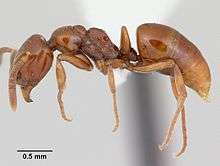Asphinctopone
Asphinctopone is a small genus of rarely encountered Afrotropical ants in the subfamily Ponerinae.
| Asphinctopone | |
|---|---|
 | |
| A. silvestrii worker from Gabon | |
| Scientific classification | |
| Kingdom: | |
| Phylum: | |
| Class: | |
| Order: | |
| Family: | |
| Subfamily: | |
| Tribe: | |
| Genus: | Asphinctopone Santschi, 1914 |
| Type species | |
| Asphinctopone silvestrii[1] Santschi, 1914 | |
| Diversity[2] | |
| 3 species | |
| Synonyms | |
|
Lepidopone Bernard, 1953 | |
Species
- Asphinctopone differens Bolton & Fisher, 2008
- Asphinctopone pilosa Hawkes, 2010
- Asphinctopone silvestrii Santschi, 1914
Habitat and distribution
The three recognized species are known from the wet forest zones of West and Central Africa and from the Kilindi Forest Reserve in Tanzania.[3] Asphinctopone are very rarely encountered; whether this is due to actual rarity of members of the genus, or to a secretive and perhaps deeply subterranean lifestyle, is unknown.[4] Specimens are seldom found and most samples recovered consist of only one or two workers. As a measure of its rarity, a survey of leaf litter in Ghana recorded 43,824 individual ants, of which only 5 (about 0.01%) were Asphinctopone.[5] Despite this rarity, the genus is widespread in wet forest zones in leaf litter, topsoil, pieces of rotten wood and rotting vegetation on the forest floor. One worker has been found foraging in a fallen, abandoned termitary. Beyond this nothing is known of its biology. Its specialized morphology implies that it may be prey-specific, but its victims remain unknown.[6]
Taxonomy
The genus was first described by Santschi (1914) with a single species, A. silvestrii. Two more species were subsequently described: A. lucidus (Weber 1949) and A. lamottei (Bernard 1953), the latter originally ascribed by Bernard to a new genus, Lepidopone, but subsequently placed in Asphinctopone by Brown (1953). In a recent revision of the genus, Bolton & Fisher (2008) synonymised all three previously described species and described one additional species, bringing the total number of described species to two. Of these A. differens (Bolton & Fisher 2008) is known only from the holotype (collected in the Central African Republic), while A. silvestrii (now including A. lucidus and A. lamottei) has been recorded multiple times in West and Central Africa (Bolton & Fisher 2008). A third species, A. pilosa, was described by Hawkes (2010) from a single specimen the Kilindi Forest Reserve (Kilindi District, Tanzania).[7]
References
- "Genus: Asphinctopone". antweb.org. AntWeb. Retrieved 23 September 2013.
- Bolton, B. (2014). "Asphinctopone". AntCat. Retrieved 3 July 2014.
- Hawkes 2010, p. 35
- Hawkes 2010, p. 34
- Belshaw & Bolton 1994, p. 15
- Bolton & Fisher 2008, p. 53
- Hawkes 2010, p. 27
- Belshaw, R.; Bolton, B. (1994), "A survey of the leaf litter ant fauna in Ghana, West Africa.", Journal of Hymenoptera Research, 3: 5–16
- Bernard, F. (1953) La reserve naturelle integrale du Mt Nimba. XI. Hyménoptères Formicidae. Mémoires de l'Institut Français d'Afrique Noire, 19, 165–270.
- Bolton, B.; Fisher, B.L. (2008), "The Afrotropical ponerine ant genus Asphinctopone Santschi (Hymenoptera: Formicidae)." (PDF), Zootaxa, 1827: 53–61
- Brown, W.L.,Jr. (1953) Characters and synonymies among the genera of ants. Part II. Breviora, 18, 1–8.
- Hawkes, Peter G. (2010), "A new species of Asphinctopone (Hymenoptera: Formicidae: Ponerinae) from Tanzania." (PDF), Zootaxa, 2480: 27–36
- Santschi, F. (1914) Formicides de l’Afrique occidentale et australe du voyage de Mr. le Professeur F. Silvestri. Bollettino del Laboratorio di Zoologia Generale e Agraria della R. Scuola Superiore d'Agricultura, 8, 309–385.
- Weber, N.A. (1949) New Ponerine Ants from Equatorial Africa. American Museum Novitates, 1398, 1–9.


External links
